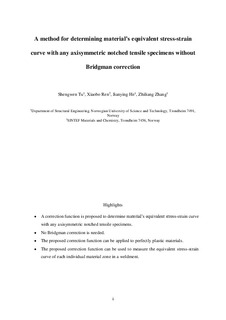| dc.contributor.author | Tu, Shengwen | |
| dc.contributor.author | Ren, Xiaobo | |
| dc.contributor.author | He, Jianying | |
| dc.contributor.author | Zhang, Zhiliang | |
| dc.date.accessioned | 2018-12-14T08:51:22Z | |
| dc.date.available | 2018-12-14T08:51:22Z | |
| dc.date.created | 2017-12-07T11:21:45Z | |
| dc.date.issued | 2017 | |
| dc.identifier.citation | International Journal of Mechanical Sciences. 2018, 135 656-667. | nb_NO |
| dc.identifier.issn | 0020-7403 | |
| dc.identifier.uri | http://hdl.handle.net/11250/2577673 | |
| dc.description.abstract | Large deformation analyses of problems such as plastic forming, ductile fracture with finite element method need a full range of material's equivalent stress-strain curve or flow stress-strain curve. The equivalent stress-strain curve determined from the smooth round bar specimen should be corrected after diffuse necking, since tri-axial stress state occurs in the neck. The well-known Bridgman correction method is a candidate, however, it is not accurate as the strain increases. Furthermore, it is impossible to measure the equivalent stress-strain curve of each individual material zone in a weldment with cross weld tensile tests. To cope with these challenges, a correction function and an associated test procedure are proposed in this study. With the proposed procedure, the true stress-strain curve from any axisymmetric notched tensile specimen can be converted to the material's equivalent stress-strain curve accurately and no Bridgman correction is needed. The proposed procedure can be applied to both perfectly plastic and strain hardening materials. The equivalent stress-strain curve of each individual material zone in a weldment can also be measured with the proposed procedure. | nb_NO |
| dc.language.iso | eng | nb_NO |
| dc.publisher | Elsevier | nb_NO |
| dc.title | A method for determining material's equivalent stress-strain curve with any axisymmetric notched tensile specimens without Bridgman correction | nb_NO |
| dc.title.alternative | A method for determining material's equivalent stress-strain curve with any axisymmetric notched tensile specimens without Bridgman correction | nb_NO |
| dc.type | Journal article | nb_NO |
| dc.description.version | submittedVersion | nb_NO |
| dc.source.pagenumber | 656-667 | nb_NO |
| dc.source.volume | 135 | nb_NO |
| dc.source.journal | International Journal of Mechanical Sciences | nb_NO |
| dc.identifier.doi | 10.1016/j.ijmecsci.2017.12.012 | |
| dc.identifier.cristin | 1524102 | |
| dc.relation.project | Norges forskningsråd: 228513 | nb_NO |
| dc.description.localcode | This is a submitted manuscript of an article published by Elsevier Ltd in International Journal of Mechanical Sciences, 7 December 2017. | nb_NO |
| cristin.unitcode | 194,64,45,0 | |
| cristin.unitname | Institutt for konstruksjonsteknikk | |
| cristin.ispublished | true | |
| cristin.fulltext | preprint | |
| cristin.qualitycode | 1 | |
